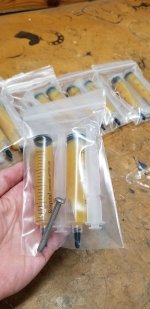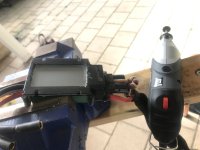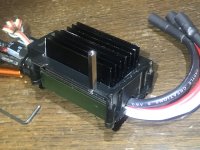You are using an out of date browser. It may not display this or other websites correctly.
You should upgrade or use an alternative browser.
You should upgrade or use an alternative browser.
Dave's 80:1 RC mid drive kit build log
- Thread starter tangentdave
- Start date
tangentdave
1 kW
36t rear with a 32t front is enough to climb any trail. You could go larger rear if your wanted to make climbing the sides of quarry pits easy on the motor, but the 36t/32t combo could do that too.
cr0m08
1 W
I can confirm the 3220 kit has loads of grunt. I'm running 20-38 motor-crank 32-17/34 rear. Damn thing lifts front wheel in lowest 3 gears, I mean seriously gotta be carful on throttle.
But if you really want to run a saint to a 42T..... just fit the Oneup RadR cage on the saint. But I don't think you need it!
https://www.oneupcomponents.com/products/radr-cage
I put Rad cage (not RadR) on my shadow XT 10 speed and it reaches 42T no problem.
But if you really want to run a saint to a 42T..... just fit the Oneup RadR cage on the saint. But I don't think you need it!
https://www.oneupcomponents.com/products/radr-cage
I put Rad cage (not RadR) on my shadow XT 10 speed and it reaches 42T no problem.
tangentdave said:John's Airborne Plauge uses a 168mm long mount. There's not much room between the crankset and the motor freewheel for a tension device if the two centers are closer (168 from center of BB to center of motor). Perhaps a gear solution like the Paradox kit could get it closer...but chains are pretty damn robust.
Thanks Dave, much appreciated. Still exploring options for the mounting on a new frame
tangentdave
1 kW
Ok, have posted a couple 'service bulletins' on the website. Nothing ground breaking- how to shift the BB spindle left/right for chainline and a walk through of the greasing interval. It's looking like an initial grease change around the 100-200 mile point isn't a bad idea, and probably every 500-750 miles thereafter (depending on abuse of course). If you're like me and ride with enough throttle to keep the unit at 100C, a more frequent grease interval isn't a bad idea either. Vigogrease has a pretty high operating temp (over 300F), but changing the grease literally only takes a few minutes and it's cheap stuff.
The only tools needed for the maintentance are a 4mm hex wrench, a long M6 bolt that's fully threaded, and Vigogrease. All this is available online and I've made up little packets for people if they prefer to not to think about it. I also add a touch of hexagonal Boron Nitride to the Tangent grease. Each dispenser holds 20mL and is the proper amount to use during the maintenance.

The only tools needed for the maintentance are a 4mm hex wrench, a long M6 bolt that's fully threaded, and Vigogrease. All this is available online and I've made up little packets for people if they prefer to not to think about it. I also add a touch of hexagonal Boron Nitride to the Tangent grease. Each dispenser holds 20mL and is the proper amount to use during the maintenance.

Hi Guys,
I have a a few questions if anyone can help.
I am looking to relocate my controller and am wondering if the standard 8 awg wiring for the kit is suitable for extending the three cables from the motor to the controller or if something more heavy duty is required to handle phase currents as the motor cables are much stiffer due to a heavy copper (?) fill?
Also I am exploring the possibility of power isolation switches for the battery like the big reg key ones we see on track cars, now I assume they are rated for very high cranking amps so could handle the 100-150 ish battery amps we pull for the 3220 motor but I am trying to find what the continuous rating is for them as I'd hate to install one and then melt it immediately!
This power isolation switch also led me to wondering about if we can install a secondary key switch for the cycle analyst...just an added layer of security?
Thanks for any help
I have a a few questions if anyone can help.
I am looking to relocate my controller and am wondering if the standard 8 awg wiring for the kit is suitable for extending the three cables from the motor to the controller or if something more heavy duty is required to handle phase currents as the motor cables are much stiffer due to a heavy copper (?) fill?
Also I am exploring the possibility of power isolation switches for the battery like the big reg key ones we see on track cars, now I assume they are rated for very high cranking amps so could handle the 100-150 ish battery amps we pull for the 3220 motor but I am trying to find what the continuous rating is for them as I'd hate to install one and then melt it immediately!
This power isolation switch also led me to wondering about if we can install a secondary key switch for the cycle analyst...just an added layer of security?
Thanks for any help
I am looking to relocate my controller and am wondering if the standard 8 awg wiring for the kit is suitable for extending the three cables from the motor to the controller or if something more heavy duty is required to handle phase currents as the motor cables are much stiffer due to a heavy copper (?) fill?
Where were you thinking about relocating to? Shorter phase wires the better. I think I have about 12" phase wires on my eskate. 8ga phase wires I think is plenty on short distances.
Where were you thinking about relocating to? Shorter phase wires the better. I think I have about 12" phase wires on my eskate. 8ga phase wires I think is plenty on short distances.
tangentdave
1 kW
Personally, I'd use 8ga to extend the phase wires. The Astro phase cables seem stiff because they're made of fewer but thicker individual copper strands than 'flexible' cables with many tiny strands. The length of wire between the ESC and engine is much less important than the length between ESC and battery pack (although never disconnect the ESC while engine is turning, catastrophic ESC damage can result).
E1, your kit will have a maintenance packet, they all will.
E1, your kit will have a maintenance packet, they all will.
Re battery isolation: After an event that let all the magic smoke out of my Luna switch, I installed a switchable breaker rated at 48 V, 150 amps. Different values are available to be chosen depending on where you want the circuit to blow. This is under rated for a 52 v battery, however as we are not switching under load and will infrequently flip the breaker - I am betting it will last with little risk of arcing welding contacts or other dire failures.
Bussmann CB285-150 Surface-Mount Circuit Breakers, 150 Amps
Working well so far.
Bussmann CB285-150 Surface-Mount Circuit Breakers, 150 Amps
Working well so far.
knurf
100 W
- Joined
- Aug 28, 2016
- Messages
- 129
Just being able to quickly reach the main battery XT90 provides with a lot of safety already. I’ve had to pull it on a runaway throttle once (on another bike, not a tangent kit) and it was pretty controlled.
But I would like a motorcycle style killswich too, reachable by just moving my thumb. Letting go of the handlebar in that situation can be a bit scary
But I would like a motorcycle style killswich too, reachable by just moving my thumb. Letting go of the handlebar in that situation can be a bit scary
tangentdave said:Personally, I'd use 8ga to extend the phase wires. The Astro phase cables seem stiff because they're made of fewer but thicker individual copper strands than 'flexible' cables with many tiny strands. The length of wire between the ESC and engine is much less important than the length between ESC and battery pack (although never disconnect the ESC while engine is turning, catastrophic ESC damage can result).
E1, your kit will have a maintenance packet, they all will.
Thanks Dave,
I'll pick some more up tomorrow. I was only asking as I assumed the motor wire needed to be thicker due to higher peak phase amps and having melted my battery wires already
cr0m08
1 W
From the CastleCreations site on wiring for ESC,
"With a sensorless brushless system, extremely low resistance wire is required to enable the ESC to read the extremely low voltage back EMF; this is crucial in ensuring smooth easy motor starts."
I thought I also remember reading the phase wires should be kept short for the same reason, but I can't find it at moment (um maybe I got that bit wrong )
)
"With a sensorless brushless system, extremely low resistance wire is required to enable the ESC to read the extremely low voltage back EMF; this is crucial in ensuring smooth easy motor starts."
I thought I also remember reading the phase wires should be kept short for the same reason, but I can't find it at moment (um maybe I got that bit wrong
knurf
100 W
- Joined
- Aug 28, 2016
- Messages
- 129
Also a heads up; if you're messing with the bullet and phase wires from the astro, be careful to make sure ALL of these strands are soldered to individually. I had an ongoing problem with overheating with my kit because of this.
So the bunch of thicker strands going into the bullet connector from the motor - these are made of the actual motor winding wire, so each will be isolated from each other. Make sure they are stripped of isolation and soldered properly. The motor should really have flexible wires going out instead, as these are probably much more sensitive to wiggling.
So the bunch of thicker strands going into the bullet connector from the motor - these are made of the actual motor winding wire, so each will be isolated from each other. Make sure they are stripped of isolation and soldered properly. The motor should really have flexible wires going out instead, as these are probably much more sensitive to wiggling.
cr0m08
1 W
I decided to follow Dave's upgrade of ESC and add more cooling to my HV160. A little time after I bought it, Dave advised me there had been some reliability issues with HV160. I'm running 12s not 14s with slightly lower gearing, and I'm hoping this will help its reliability. But I thought, a little extra cooling couldn't hurt. So for those that have HV160, this is what I did. I found heatsinks 13x60mm (4) in local electronics shop. Two can be put on the back of unit if cut away the excess plastic strip up the rear (cut heat sink to 55mm length). And one on each side of the existing heat sinks. I used half millimetre thick adhesive heat transfer tape as I couldn't easily source locally any adhesive heat sink past. I also used 32mm long PCB spacers to lift the HV160 from its mount point and allow room for the rear heatsink. Anyone with HV160 experience, think this will help? I'm planning to attack my HV80 next with similar, smaller heat sinks.
Attachments
cr0m08
1 W
hahaha, yeah my mount location is shitty for potential water damage, great for air flow cooling (bottom side of downtube), BUT ! My Location being Western Australia, from Perth going north and east, is in my opinion, god damn desert! Summer temp's are 38-45C most of the summer with little chance of rain. Still is chances of water damage after a lingering puddle perhaps. Having also smashed my hip years ago and still retain metal in there, I'm a bit scared riding when its wet and greasy  , so usually don't. I probably ride a bit tame compared to most of the Tangent owners, but I just can't resist the awesome power wheelies and the occasional rush of blood that turns the brain off and the wrist on! Thanks Dave!
, so usually don't. I probably ride a bit tame compared to most of the Tangent owners, but I just can't resist the awesome power wheelies and the occasional rush of blood that turns the brain off and the wrist on! Thanks Dave! 
But I'll post if any further issues happen.
But I'll post if any further issues happen.
tangentdave
1 kW
Yes to those cooling fins. I notice a difference on the Talons with the extra fins. I'm not sure the reason for the Talon showing higher reliability than the HV160, but the RC forums generally agree the Talon is tougher and runs cooler.
Full disclosure: I'm seeing a decrease in reliability of the Talons over the last 6 months. There have been about 5 out of 30 or so that I've shipped with gen2 kits that have either fireballed or simply quit on customers during the initial break-in period (first 10-20 miles). Previously with gen1, 2 Talons out of 60 died not due to water damage. I'm speculating here, but I think Castle may have altered something- all the ESCs now arrive with the latest firmware (released 4 months ago), which means they've been manufactured recently. The previous ESCs that didn't die as often arrived with old firmware (sometimes years old). The other differences with the gen2 kit are integrated engine (each is tested with a megger to >1Mohm phase isolation) and a switch to oxygen-free copper battery cables (from copper-clad aluminum). According to a couple enginerd websites, the calculated inductance of a given cable is near identical whether it's Al or Cu.
I think it's time to start with FOC anyway, reports are it reduces our motor heat by half (oh man the Talon makes a lot of torque tho).
-dave
Full disclosure: I'm seeing a decrease in reliability of the Talons over the last 6 months. There have been about 5 out of 30 or so that I've shipped with gen2 kits that have either fireballed or simply quit on customers during the initial break-in period (first 10-20 miles). Previously with gen1, 2 Talons out of 60 died not due to water damage. I'm speculating here, but I think Castle may have altered something- all the ESCs now arrive with the latest firmware (released 4 months ago), which means they've been manufactured recently. The previous ESCs that didn't die as often arrived with old firmware (sometimes years old). The other differences with the gen2 kit are integrated engine (each is tested with a megger to >1Mohm phase isolation) and a switch to oxygen-free copper battery cables (from copper-clad aluminum). According to a couple enginerd websites, the calculated inductance of a given cable is near identical whether it's Al or Cu.
I think it's time to start with FOC anyway, reports are it reduces our motor heat by half (oh man the Talon makes a lot of torque tho).
-dave
cr0m08
1 W
I'm not up with the tech at mo, can someone briefly lay out the difference between our CC HV units and the FOC and VESC units? Or point me to a thread that does? Don't really want to take Daves thread too far off topic.
cr0m08
1 W
Also I would have thought the Talon's physical build would be reason for its reliability? With the 20A bec inbuilt it has more physical mass/die-cast metal body to create heatsink to start with for both ESC and BEC. So following the historical findings of hub motors, those with more mass can absorb more energy and have more chance to dissipate the heat before saturation once power levels drop?
tangentdave
1 kW
Castle uses passive freewheeling in their ESCs. Ideally we want active freewheeling so partial throttle/load situations don't generate so much heat in the ESC.
[youtube]uqzOQGiwGnE[/youtube]
FOC is entirely different and more advanced than active freewheeling.
[youtube]uqzOQGiwGnE[/youtube]
FOC is entirely different and more advanced than active freewheeling.
cr0m08
1 W
Just wondering if anyone made progress with the rather expensive 200A VESC? Looked like a couple people were going to try it?
http://www.fightingrobots.co.uk/threads/13621-300a-vesc-in-the-works-feature-suggestions-wanted/page19
https://vesc-project.com/node/339
Do I understand correctly that these units run in sine wave, so better efficiency, but still sensorless so can suit the astro 3220?
http://www.fightingrobots.co.uk/threads/13621-300a-vesc-in-the-works-feature-suggestions-wanted/page19
https://vesc-project.com/node/339
Do I understand correctly that these units run in sine wave, so better efficiency, but still sensorless so can suit the astro 3220?
Similar threads
- Replies
- 4
- Views
- 411
- Replies
- 15
- Views
- 5,141
- Replies
- 25
- Views
- 3,086
- Replies
- 4
- Views
- 982
- Replies
- 12
- Views
- 10,561



